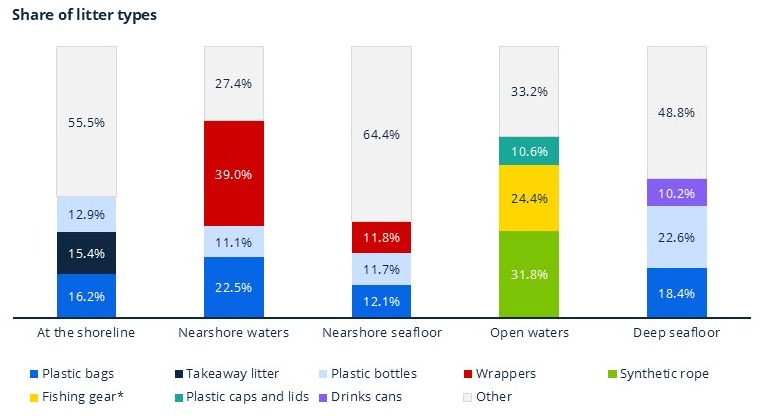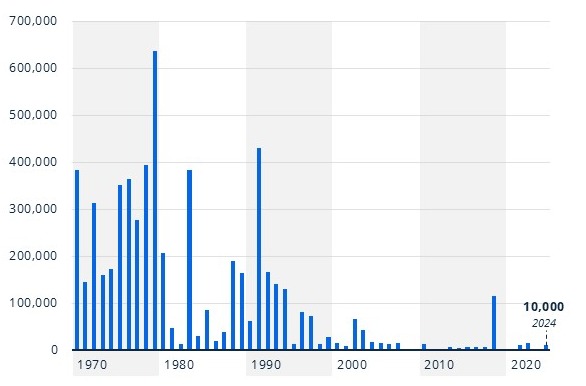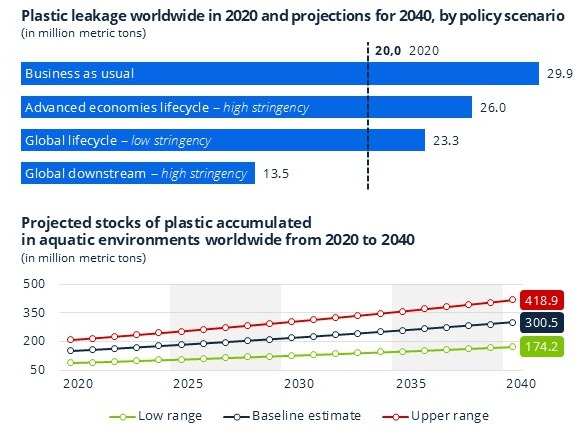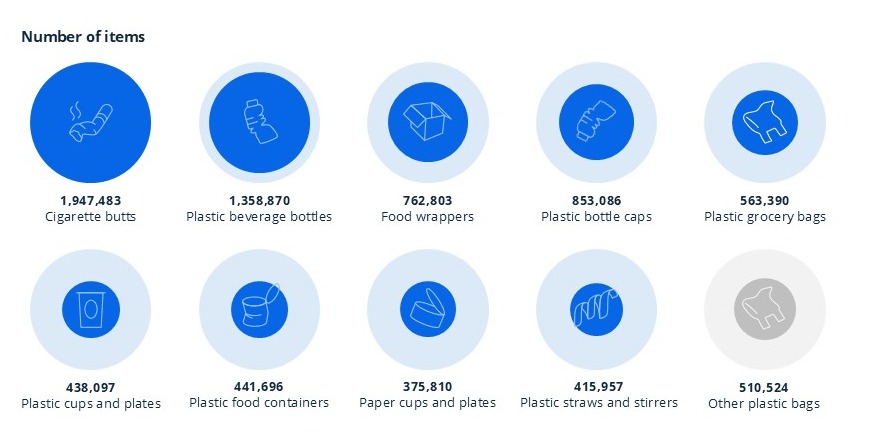State of the Oceans 2025 › Marine pollution
The ocean is used as a waste bin
Vast quantities of solid and liquid waste have been flowing into the oceans over the past decades. Improper waste management on land and deliberate discarding of waste and toxins by ships and vessels in the ocean are the primary causes of marine pollution. Due to regulatory gray areas for international waters, the oceans have been used as illegal dumping grounds.
Plastic pollution is a planetary threat, affecting nearly every marine and freshwater ecosystem. According to the IUCN, at least 14 million metric tons of plastic enter the ocean annually, with plastic alone accounting for some 80 percent of all marine debris. As the most abundant form of litter in marine environments, debris from plastic waste has been found everywhere, from surface waters to deep-sea sediments (page 33).
Based on the sources of plastic pollution in oceans, plastic debris can be distinguished as land-based (improper waste disposal, overflow of rivers) and ocean-based (fishing and aquaculture). Due to many countries lacking proper waste management infrastructure, plastic leakage mainly occurs through ocean waterways (page 31). Plastic waste often degrades into smaller particles. As marine life accidentally ingests these smaller pieces of plastic, plastics eventually enter the food chain in a trophic transfer process.
The fifth session of the Intergovernmental Negotiating Committee (INC-5) on Plastic Pollution, held in South Korea in 2024, concluded without reaching a final agreement on a global treaty to curb plastic pollution. Negotiations will continue in Switzerland in August 2025 in an attempt to reach a consensus.
Oil spills – a major threat to marine organisms
Oil spills, which happen primarily in the ocean, are caused by accidents involving tankers, barges, pipelines, refineries, drilling rigs, and storage facilities. Additionally, ships and boats that use fossil fuels inevitably release fuel residue and waste products into the ocean over the course of operation. Because oil is less dense than water, oil spills spread rapidly across the surface to form a thin oil slick. The presence of oil on the ocean surface is detrimental to marine birds and other animals that can either ingest oil or get covered by the oil slick, causing them difficulties with movement that, if left unaided, result in their injury or death.
To tackle such issues, international treaties including OILPOL and MARPOL were agreed in the 1950s and 1970s, respectively, leading to a consequent tightening of local legislation on the matter. As a result, the number of oil spills has decreased significantly since the turn of the century.
Oil spills remain a concern, but the quantity of oil spilt has decreased
Global oil tanker spills from 1970 to 2024, by volume
Quantity in metric tons
Notes: Worldwide; 1970 to 2024
Sources: ITOPF; ID: 268557; Text: Clarkson Research Services; VSM; ID: 264013; ITOPP;ID: 268553
Most crude oil and natural gas traded between continents are transported across the sea via shipping tankers or undersea pipelines. In 2024, the global volume of crude oil in seaborne trade reached two billion metric tons. Accidental leaks from oil tankers are uncommon, but their effects are catastrophic.
The incident rate of oil spills has dropped significantly since the beginning of the century. The largest leak in recent history was recorded in 1979, adding up to 636,000 metric tons. By way of comparison, the oil leaked from tanker incidents worldwide amounted to about 10,000 metric tons in 2024.
Despite the lower volume of leakage, the amount of oil leaked in a single incident can be devastating. The damage caused depends on several factors, from the environmental conditions to the sensitivity of affected areas. The clean-up of such leaks requires a massive effort, as oil floats on the surface and can disperse from the point of the leak to affect a far larger area.
How does human-generated plastic waste enter the marine environment?
The major sources and pathways of plastic waste to the oceans

Sources: UNEP
Plastic waste is projected to continue accumulating in the oceans
Plastic leakage worldwide in 2020 and projections for 2040, by policy scenario (in million metric tons)
In 2020, approximately 20 million metric tons of plastic leaked into the environment, contributing to an estimated 152 metric tons of accumulated plastic waste in rivers and oceans. Without new and effective policies, annual plastic leakage is projected to increase by 50 percent by 2040, reaching 30 metric tons.
Under a baseline scenario (continuation of current policies), plastic waste generation will rise from 360 metric tons in 2020 to 617 metric tons in 2040, 119 of which being mismanaged waste, and only six percent of plastics used will come from recycled sources in that year.
Plastic waste enters the marine environment through a variety of land- and sea-based pathways (see previous page). Poor waste management, urban runoff, industrial discharges, and tourism are major land-based contributors, while lost fishing gear, shipping, and aquaculture activities represent key sea-based sources. Plastic debris from these sources is often carried to the ocean by rivers and coastal winds, highlighting the urgent need for upstream interventions across sectors.
The reach and composition of marine plastic pollution
Distribution of litter types found in oceans worldwide as of 2021
Share of litter types

Notes: Worldwide; *excludes nets
Sources: Morales-Caselles et al; The Guardian; ID: 1337754; Text: World Economic Forum
Plastic is seemingly everywhere, with several types of litter found in most marine environments. In a
2021 global study of ocean litter, plastic bags accounted for more than 16 percent of the waste found at the shoreline.
Levels of marine plastic pollution and the effects on species vary significantly depending on the geographic location and subsequent exposure. Nevertheless, fish, seabirds, sea turtles, and marine mammals can get entangled in or ingest plastic debris, causing suffocation, starvation, and drowning.
Furthermore, microplastics and nanoplastics found in oceans enter the marine food chain and eventually reach humans during seafood consumption.
Response efforts to global marine pollution
Global waste items found in oceans 2023
Many organizations and governmental agencies have taken initiatives to manage and control the waste that ends up in the oceans.
One such effort is the International Coastal Cleanup. The annual event, which has taken place every year since 1986, is organized by the nonprofit organization Ocean Conservancy. The movement gathers thousands of volunteers in more than 70 countries to remove waste from the coasts.
Cigarette butts made up around 1.9 million of the more than 14 million waste items collected on coasts worldwide in 2023. Almost 1.4 million plastic beverage bottles were also picked up.
CONTACT
Get in touch with us!
Do you still have questions about our services or want to become a Statista reference?
Feel free to contact us anytime via this form.


